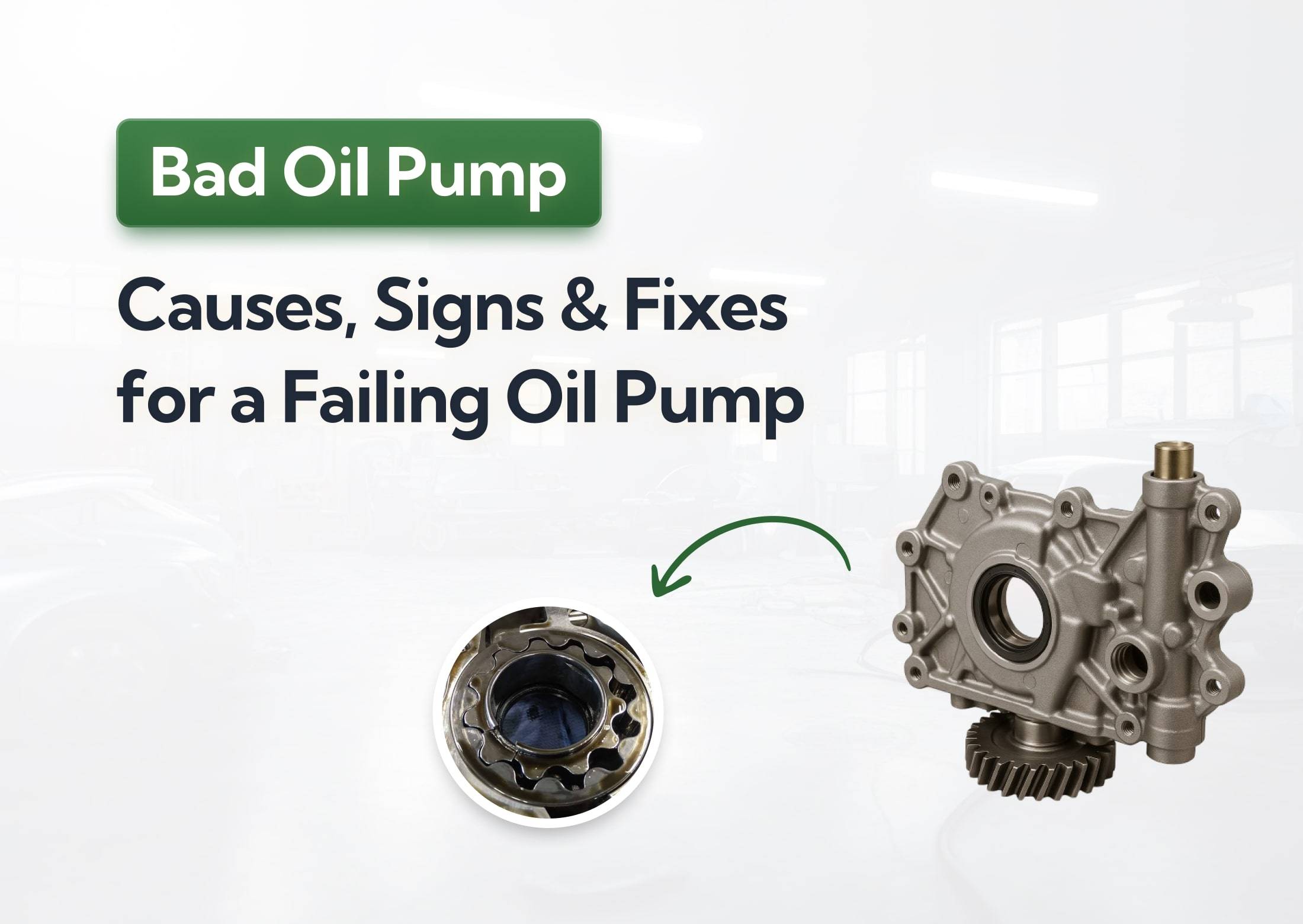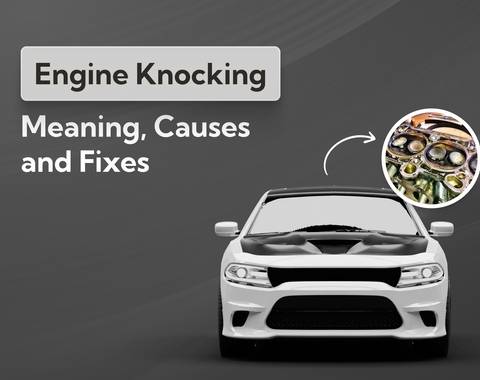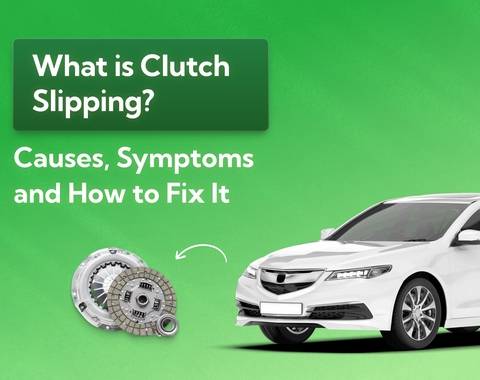Bad Oil Pump: Causes, Signs & Fixes for a Failing Oil Pump
Your oil pump keeps your engine alive and when it starts failing, damage happens fast. Learn the signs, causes and fixes for oil pump failure, how to test pressure correctly and when it makes sense to repair it versus scrapping the car.
Last updated: 31st October, 2025

Award-winning CEO driving growth and social impact across automotive, recycling, and technology-led enterprise platforms.

Listen to this story
The oil pump’s one of those parts you never think about until it stops doing its job. And by then, you’ve usually got bigger problems on your hands. It’s the heart of your engine’s lubrication system, keeping oil flowing to every moving part so nothing grinds, seizes or melts itself to death.
Bad oil pumps usually fail for simple reasons: clogged filters, worn-out bearings, dirty oil or just old age. None of it sounds dramatic, but the consequences are.
When the pump starts to fail, the warning signs creep up quietly. Low oil pressure, noisy lifters, a sudden drop in performance… ignore these things and you’re risking a full-blown engine failure that’ll cost more than most used cars are worth.
In this guide, I’ll walk you through the signs, causes and fixes for a bad oil pump.
What's in this article
- 4. What are the common causes of oil pump failure?
- 5. How to test your oil pump
- 6. Effective solutions for fixing a failing oil pump
- 7. Cost of replacing an oil pump
- 8. Is it worth replacing a bad oil pump?
- 9. How to test your oil pump
- 10. Effective solutions for fixing a failing oil pump
- 11. Cost of replacing an oil pump
- 12. Is it worth replacing a bad oil pump?
The oil pump’s one of those parts you never think about until it stops doing its job. And by then, you’ve usually got bigger problems on your hands. It’s the heart of your engine’s lubrication system, keeping oil flowing to every moving part so nothing grinds, seizes or melts itself to death.
Bad oil pumps usually fail for simple reasons: clogged filters, worn-out bearings, dirty oil or just old age. None of it sounds dramatic, but the consequences are.
When the pump starts to fail, the warning signs creep up quietly. Low oil pressure, noisy lifters, a sudden drop in performance… ignore these things and you’re risking a full-blown engine failure that’ll cost more than most used cars are worth.
In this guide, I’ll walk you through the signs, causes and fixes for a bad oil pump.
What is an oil pump?
The oil pump is the part of your engine that keeps everything alive and moving. It pushes engine oil through all the small channels inside the block and head, making sure metal never meets metal without lubrication.
The three main types of oil pumps you’ll find in vehicles are:
- Gear pump: Uses two meshed gears to move oil efficiently and reliably.
- Rotor pump: Also called a gerotor pump, it uses an inner and outer rotor to generate pressure.
- Vane pump: Uses sliding vanes inside a rotating chamber, often found in performance or variable-pressure setups.
They all do the same thing: maintain oil pressure and flow. It circulates it under pressure so every bearing, valve and piston gets a steady flow of lubrication. Without it, friction builds up and metal-on-metal contact starts wearing out (and eventually destroying) your engine components.
What does the oil pump do?
When your engine’s running, the oil pump sucks oil up from the sump, pressurises it, and sends it through passages to the bearings, camshaft, pistons, every critical component that needs a thin film of oil to survive. It’s a continuous cycle happening thousands of times a minute.
An oil pump’s four main functions are:
- Lubricates engine components: The oil pump keeps every moving part from crankshaft bearings to cam lobes coated in a thin layer of oil. That film prevents direct metal-on-metal contact, cutting friction and stopping the kind of microscopic wear that kills engines over time.
- Maintains oil pressure: The pump regulates pressure inside the system, making sure oil reaches even the furthest corners of the engine. If that pressure drops, you risk oil starvation, which is a fancy way of saying parts start grinding, overheating and seizing.
- Cools the engine: Oil doesn’t just lubricate. It carries heat away from pistons, bearings and other hot zones. The pump keeps that flow steady so heat doesn’t build up in one place. Think of it as a secondary cooling system working alongside your radiator.
- Cleans the engine: As oil circulates, it picks up dirt, metal shavings and combustion byproducts. The pump pushes all that through the oil filter to keep contaminants out of delicate parts. Clean oil means cleaner internals, smoother performance, and a longer engine lifespan.
In most modern cars, the oil pump sits near the bottom of the engine, drawing oil from the sump (that’s the reservoir under the crankcase) and pushing it through a filter before it reaches the rest of the system. Simple job, huge responsibility.
Signs of a bad oil pump
You might spot low oil pressure, engine noise or flickering warning lights. In rarer cases, pressure can spike if the relief valve sticks. The trick is catching these early. Delay it, and you’re gambling with your engine’s entire lifespan.
In my four decades working in the motor trade, there are six bad oil pump signs I see more often than anything.
Low oil pressure
Low oil pressure is the classic sign your oil pump is on its way out. When the pump can’t circulate oil properly, pressure drops across the whole system and your engine starts running without oil in certain parts.
Common symptoms include:
- The oil pressure warning light flickering or staying on
- A ticking or knocking sound from the engine
- Loss of power or sluggish acceleration
- A hotter engine than usual, especially at idle
An engine running with low oil pressure is like you running with low blood pressure. Vital components aren’t getting enough oil, which causes them to rub directly against each other, overheat and wear themselves down.
Engine overheating
I've already touched on this one above because it goes hand in hand with the other symptoms. Overheating is a direct result of the friction low oil pressure causes. Without steady oil flow, heat can’t dissipate evenly, so the engine starts cooking itself from the inside out.
Typical signs include:
- The temperature gauge creeping higher than normal
- Burning smells from under the bonnet
- Steam or smoke coming from the engine bay
- Rough idling or reduced power as heat builds up
Heat kills performance. When the engine runs too hot, the oil thins, pressure drops even further and combustion efficiency nosedives. In other words, too much heat means wasted power, warped components and a shorter engine lifespan.
Unusual engine noises
A healthy engine hums. A bad oil pump makes it clatter, tick and groan. When oil flow drops, metal parts lose their cushion of lubrication and you start hearing exactly where that friction’s happening.
Listen for:
- Tapping or ticking from the top end (often the lifters or valves)
- Knocking or rumbling deeper in the block (usually the crankshaft or bearings)
- Whining that rises with engine speed (the pump gears themselves struggling)
Increased engine wear
Over time, unlubricated components grind against each other, creating microscopic grooves that worsen with every mile.
Bearings lose their smooth surface, piston rings start leaking compression, and cam lobes wear down until the timing’s off. Even if the engine still runs, efficiency drops, oil consumption climbs and performance slowly dies off.
The real danger? Once that kind of wear sets in, it’s irreversible without a full rebuild.
Sticking or seizing engine parts
When oil flow drops for too long, things stop sliding and start sticking. When the camshafts, pistons and bearings overheat to a certain point, they start to expand. Eventually, they weld themselves together under pressure.
This won’t happen overnight. You’ll first notice sluggish acceleration or rough starts, but eventually the engine will struggle to turn over at all. At that point, it’s game over. Even forcing the engine to crank can snap rods or crack the block.
High oil pressure
While most bad oil pumps cause low pressure, the opposite can happen too (though it’s rare). If the pump’s pressure relief valve sticks shut, it causes high oil pressure, which is just as dangerous.
You might notice:
- The oil pressure gauge sitting unusually high
- Oil leaks around seals or gaskets
- Engine running rough or hesitating under load
- A check engine light triggered by pressure sensor readings
Instead of starving the engine, excess pressure forces oil through seals and gaskets it’s not supposed to reach. Eventually, those seals and gaskets burst, leading to a complete loss of oil. In serious cases, the oil filter itself can rupture under the pressure.
What are the common causes of oil pump failure?
Oil pumps don’t just give up for no reason. Sometimes it’s simple neglect, like running low on oil or skipping changes. Others it’s dirty oil clogging the pickup screen, worn internal gears or a pressure relief valve that’s stuck open. Deeper engine damage can even play a part.
In the next sections, we’ll break down what triggers each of these causes, what they do to your engine and how to spot them before they turn into a full-blown disaster.
Low oil levels
The oil pump can’t move what isn’t there and once it starts sucking air, pressure tanks. Without that steady circulation, metal parts grind, temperatures rise and friction chews through surfaces.
Low oil levels can happen for simple reasons: leaks, burning oil in older engines or just skipping checks between services. But whatever the cause, the result’s the same: the pump’s forced to work harder with less lubrication, wearing itself out in the process.
Contaminated oil
Dirty oil is like sandpaper. The pump’s job is to circulate and dissipate, so every metal shaving and sludge particle that slips past the filter ends up grinding down the engine’s internal gears and scarring the housing. Over time, that wear kills efficiency and stops the pump from holding pressure properly.
Even if your oil’s clean, I come across a surprising number of drivers who use the wrong type of oil. If it’s too thick, the pump struggles to circulate it (especially on cold starts). Too thin, and it can’t hold pressure once the engine’s hot. Both lead to poor lubrication and excess friction.
Worn-out pump components
Like any moving part, oil pumps wear down over time. The internal gears and bearings that create pressure gradually lose their tight clearances and once that happens, the pump can’t push oil with the same force it used to. Age, high mileage and dirty oil accelerate this wear.
To spot component wear, look for:
- Flickering oil pressure light (especially noticeable at idle)
- Consistently low oil pressure readings on the gauge
- Tapping or knocking noises from the engine
- Sluggish performance or rough idling
- Increased engine temperature
Faulty pressure relief valve
The pressure relief valve is a safety release for your oil system. It keeps everything balanced.
If it’s stuck open, the pump can’t build enough pressure, starving the engine of oil. If it’s stuck closed, pressure shoots through the roof, blowing past seals and gaskets. Either way, you’re looking at leaks, erratic readings and a system that’s completely out of sync.
If you notice physical leaks, strange noises, fluctuating oil temperatures and/or irregular water temperatures, this might be the cause.
Lack of regular oil changes
You need an oil change every 5,000 to 7,500 miles (or 6-12 months) but millions of drivers put it off because they underestimate just how important it is for your engine.
Over time, oil breaks down from heat, pressure and contamination. In the process, they lose the additives that keep it flowing smoothly. What’s left is a thick, sludgy mess that clogs the pump pickup and starves the system.
That sludge also traps heat and debris, which grind away at internal components. The oil pump ends up working overtime to push heavy, dirty oil through narrow passages until it wears itself out.
Internal engine damage
When bearings are worn or metal shavings are floating around after internal damage, they eventually destroy the pump from the inside out. Bits of debris can jam the gears or clog the pickup, and that sudden restriction is often what finishes off a pump that was otherwise fine.
Damage to other engine components like the crankshaft and bearings can also affect the oil pump’s capacity to dissipate oil throughout the engine.
How to test your oil pump
If you suspect the oil pump’s on its last legs, testing it properly saves you all the guesswork. The easiest way to confirm a problem is by checking oil pressure, ideally with a mechanical gauge since dash readings aren’t always accurate.
Here’s a quick way to go about it:
- Check the oil pressure gauge. If your car has one, start the car and watch the built-in oil pressure gague on the dashboard. 25 to 65 PSI is the range for most cars (25 to 35 PSI at idle, 40 to 65 PSI when accelerating), but your manual will give you the specifics. Sudden changes and unusually high or low pressure are early red flags.
- Use a mechanical pressure gauge. Remove the oil pressure sensor, screw the gauge into its port and start the engine. Check readings at idle and while revving lightly. Pressure should rise smoothly and stay within your car’s recommended range.
- Inspect the oil pressure relief valve. Locate it near the pump or inside the housing. Remove it carefully and check that the spring and piston move freely. Clean out any sludge, metal flakes or carbon buildup that could cause it to stick open or closed (both affect pump performance).
- Check for oil pump noise. Listen for whining, grinding and rattling sounds, particularly when the engine’s cold. That’s often a sign of worn gears or bearings inside the pump.
- Examine the oil pump for wear or damage. If you’re removing it (or already inside the engine), look for scoring, metal shavings or loose tolerances between gears. If you notice damage, take the car to a mechanic.
If pressure readings are way off or you’re unsure what you’re seeing, it’s better to call in a professional. A qualified mechanic can run more precise diagnostics, check internal clearances and tell you whether it’s the pump itself or something else in the system causing the issue.
Effective solutions for fixing a failing oil pump
Once you’ve confirmed the oil pump’s the culprit, your next step is fixing it before it takes the rest of the engine with it. Depending on the cause and how far things have gone already, that might mean a full replacement or just a deep clean, new valve or quick additive treatment to buy you time.
Replacing the oil pump
When the pump’s too worn or damaged to save, replacement is the only possibility. You’ll need basic tools for this: a socket set, torque wrench, drain pan, new pump, gasket and fresh oil.
Start by draining the oil, removing the oil pan and disconnecting the old pump from its mount and pickup tube. Then clean the surfaces, install the new pump and torque it to spec. Once it’s reassembled, refill it with oil and check for leaks or pressure changes on startup.
It’s not a quick job (usually a few hours), but it’s the only permanent fix for a failing unit.
Cleaning and inspecting the oil pump
If the pump isn’t too badly worn, a clean and inspect might do the trick. This is worth trying when the issue seems linked to sludge, contaminated oil or a clogged pickup.
Remove the pump, open the housing and clear out debris or varnish buildup from the gears and relief valve. Check for scoring or grooves inside the casing as well. If they’re deep or the gears feel loose, replacement’s your best bet.
A clean pump in good condition can often be reinstalled safely, as long as the oil and filter are changed immediately afterward.
Pressure relief valve replacement
If oil pressure’s erratic or unusually high and the pressure relief valve shows leaks or signs of physical damage, that might be the real problem. Replacing it is relatively simple compared to a full pump swap.
Once you’ve removed the pump or housing cover, take out the valve assembly (usually a spring-loaded piston). Clean the area, then install the new valve and spring, making sure it moves freely.
A smooth, responsive valve restores proper oil pressure balance and stops the system from overloading seals or starving bearings.
Checking oil pump bearings and gears
Sometimes the pump itself isn’t destroyed, just the bearings or gears inside are worn down. If they’re replaceable on your pump model, swap them out before things get worse.
Look for scoring, metal flakes, or uneven wear on the teeth and shafts. Any binding or excessive play means the pump won’t maintain consistent oil flow. Fresh bearings and properly meshed gears bring that flow and pressure back to normal.
Using oil additives for temporary fix
Oil additives can help, but only for minor short-term issues. Certain high-detergent and friction-modifying additives improve oil flow, reduce noise and clean light sludge buildup inside the pump.
But I want to be clear here: they’re not a cure. If pressure’s dropping or the pump’s already damaged, additives are just a stopgap to buy a few weeks of safe running before you can get the car to a garage. Use them only when you’re planning to get the real fix done soon.
Cost of replacing an oil pump
According to Fixster, the average oil pump replacement in the UK costs between £492 and £1,008, depending on the car and where you take it. That figure covers both parts and labour, with labour making up the bulk of the cost, particularly if the pump’s buried deep in the engine.
The main factors affecting cost are:
- Vehicle make and model: Luxury and high-performance engines require more complex, expensive pumps.
- Labour rates: A small independent garage might charge £60 an hour, while a main dealer could charge double. Cars that need specialised service (e.g. a BMW or Porsche) will pay higher hourly rates.
- Accessibility: Some engines let you reach the pump easily through the oil pan while others require removing half the engine bay. That plays a role in how many hours it takes to finish the job.
Now… replacing an oil pump isn’t cheap, but it’s nowhere near as painful as what happens if you ignore it. If a failed pump starves the engine of oil, you’re looking at spun bearings, seized pistons or a full engine replacement — repairs that easily cost £3,000 to £10,000 or more.
Is it worth replacing a bad oil pump?
Whether it’s worth replacing a bad oil pump really comes down to one thing: the value of the car versus the damage risk. Yes, replacing the pump keeps your engine healthy. But if the car’s on its last legs and already suffers from deeper problems, that money is better spent elsewhere.
When replacing the oil pump is worth it
If your car’s relatively new, well-maintained and still worth a few thousand pounds, then absolutely replace it. The pump is essential for keeping the engine alive and once you’ve fixed it, the car should run reliably for years to come.
It’s also worth it if you’ve caught the issue early. If oil pressure has just started to dip or the warning light flickers occasionally, a new pump will prevent serious internal wear and save you from much bigger repairs later.
When replacing the oil pump isn’t worth it
If the engine’s already suffered damage and you’re dealing with noisy bearings, knocking sounds or metal in the oil, then replacing just the pump just won’t solve much. The new part will be working inside an already compromised system.
It’s also questionable on older cars with high mileage and ones that are only worth a few hundred pounds. Spending £800 to £1,000 on a new pump for a car worth the same barely makes sense unless you’re emotionally attached or plan to keep it long-term.
When scrapping the car makes more sense
If the engine’s seized, repair costs are spiralling or you’re facing a rebuild worth more than half the value of the car itself, the best call is to scrap your car. Even more so if your car has more than 100,000 miles or is older than 15 years.
Get a scrap quote from us and see how much you’d realistically get for your car in today’s condition (it’s free and takes 30 seconds). If the repair costs close to or more than that figure, cut your losses. Our collection team will pick up the car free of charge, pay you on the spot via secure bank transfer and handle all the DVLA paperwork.
What the experts say

Anthony Sharkey
How to test your oil pump
If you suspect the oil pump’s on its last legs, testing it properly saves you all the guesswork. The easiest way to confirm a problem is by checking oil pressure, ideally with a mechanical gauge since dash readings aren’t always accurate.
Here’s a quick way to go about it:
- Check the oil pressure gauge. If your car has one, start the car and watch the built-in oil pressure gauge on the dashboard. 25 to 65 PSI is the range for most cars (25 to 35 PSI at idle, 40 to 65 PSI when accelerating), but your manual will give you the specifics. Sudden changes and unusually high or low pressure are early red flags.
- Use a mechanical pressure gauge. Remove the oil pressure sensor, screw the gauge into its port and start the engine. Check readings at idle and while revving lightly. Pressure should rise smoothly and stay within your car’s recommended range.
- Inspect the oil pressure relief valve. Locate it near the pump or inside the housing. Remove it carefully and check that the spring and piston move freely. Clean out any sludge, metal flakes or carbon buildup that could cause it to stick open or closed (both affect pump performance).
- Check for oil pump noise. Listen for whining, grinding and rattling sounds, particularly when the engine’s cold. That’s often a sign of worn gears or bearings inside the pump.
- Examine the oil pump for wear or damage. If you’re removing it (or already inside the engine), look for scoring, metal shavings or loose tolerances between gears. If you notice damage, take the car to a mechanic.
If pressure readings are way off or you’re unsure what you’re seeing, it’s better to call in a professional. A qualified mechanic can run more precise diagnostics, check internal clearances and tell you whether it’s the pump itself or something else in the system causing the issue.
Effective solutions for fixing a failing oil pump
Once you’ve confirmed the oil pump’s the culprit, your next step is fixing it before it takes the rest of the engine with it. Depending on the cause and how far things have gone already, that might mean a full replacement or just a deep clean, new valve or quick additive treatment to buy you time.
Replacing the oil pump
When the pump’s too worn or damaged to save, replacement is the only possibility. You’ll need basic tools for this: a socket set, torque wrench, drain pan, new pump, gasket and fresh oil.
Start by draining the oil, removing the oil pan and disconnecting the old pump from its mount and pickup tube. Then clean the surfaces, install the new pump and torque it to spec. Once it’s reassembled, refill it with oil and check for leaks or pressure changes on startup.
It’s not a quick job (usually a few hours), but it’s the only permanent fix for a failing unit.
Cleaning and inspecting the oil pump
If the pump isn’t too badly worn, a clean and inspect might do the trick. This is worth trying when the issue seems linked to sludge, contaminated oil or a clogged pickup.
Remove the pump, open the housing and clear out debris or varnish buildup from the gears and relief valve. Check for scoring or grooves inside the casing as well. If they’re deep or the gears feel loose, replacement’s your best bet.
A clean pump in good condition can often be reinstalled safely, as long as the oil and filter are changed immediately afterward.
Pressure relief valve replacement
If oil pressure’s erratic or unusually high and the pressure relief valve shows leaks or signs of physical damage, that might be the real problem. Replacing it is relatively simple compared to a full pump swap.
Once you’ve removed the pump or housing cover, take out the valve assembly (usually a spring-loaded piston). Clean the area, then install the new valve and spring, making sure it moves freely.
A smooth, responsive valve restores proper oil pressure balance and stops the system from overloading seals or starving bearings.
Checking oil pump bearings and gears
Sometimes the pump itself isn’t destroyed, just the bearings or gears inside are worn down. If they’re replaceable on your pump model, swap them out before things get worse.
Look for scoring, metal flakes, or uneven wear on the teeth and shafts. Any binding or excessive play means the pump won’t maintain consistent oil flow. Fresh bearings and properly meshed gears bring that flow and pressure back to normal.
Using oil additives for temporary fix
Oil additives can help, but only for minor short-term issues. Certain high-detergent and friction-modifying additives improve oil flow, reduce noise and clean light sludge buildup inside the pump.
But I want to be clear here: they’re not a cure. If pressure’s dropping or the pump’s already damaged, additives are just a stopgap to buy a few weeks of safe running before you can get the car to a garage. Use them only when you’re planning to get the real fix done soon.
Cost of replacing an oil pump
According to Fixster, the average oil pump replacement in the UK costs between £492 and £1,008, depending on the car and where you take it. That figure covers both parts and labour, with labour making up the bulk of the cost, particularly if the pump’s buried deep in the engine.
The main factors affecting cost are:
- Vehicle make and model: Luxury and high-performance engines require more complex, expensive pumps.
- Labour rates: A small independent garage might charge £60 an hour, while a main dealer could charge double. Cars that need specialised service (e.g. a BMW or Porsche) will pay higher hourly rates.
- Accessibility: Some engines let you reach the pump easily through the oil pan while others require removing half the engine bay. That plays a role in how many hours it takes to finish the job.
Now… replacing an oil pump isn’t cheap, but it’s nowhere near as painful as what happens if you ignore it. If a failed pump starves the engine of oil, you’re looking at spun bearings, seized pistons or a full engine replacement — repairs that easily cost £3,000 to £10,000 or more.
Is it worth replacing a bad oil pump?
Whether it’s worth replacing a bad oil pump really comes down to one thing: the value of the car versus the damage risk. Yes, replacing the pump keeps your engine healthy. But if the car’s on its last legs and already suffers from deeper problems, that money is better spent elsewhere.
When replacing the oil pump is worth it
If your car’s relatively new, well-maintained and still worth a few thousand pounds, then absolutely replace it. The pump is essential for keeping the engine alive and once you’ve fixed it, the car should run reliably for years to come.
It’s also worth it if you’ve caught the issue early. If oil pressure has just started to dip or the warning light flickers occasionally, a new pump will prevent serious internal wear and save you from much bigger repairs later.
When replacing the oil pump isn’t worth it
If the engine’s already suffered damage and you’re dealing with noisy bearings, knocking sounds or metal in the oil, then replacing just the pump just won’t solve much. The new part will be working inside an already compromised system.
It’s also questionable on older cars with high mileage and ones that are only worth a few hundred pounds. Spending £800 to £1,000 on a new pump for a car worth the same barely makes sense unless you’re emotionally attached or plan to keep it long-term.
When scrapping the car makes more sense
If the engine’s seized, repair costs are spiralling or you’re facing a rebuild worth more than half the value of the car itself, the best call is to scrap your car. Even more so if your car has more than 100,000 miles or is older than 15 years.
Get a scrap quote from us and see how much you’d realistically get for your car in today’s condition (it’s free and takes 30 seconds). If the repair costs close to or more than that figure, cut your losses. Our collection team will pick up the car free of charge, pay you on the spot via secure bank transfer and handle all the DVLA paperwork.
About Car.co.uk

Share on
Latest news & blogs










